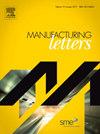通过先前的xhv -充足的激光脱氧,提高冷轧粘合效率
IF 1.9
Q3 ENGINEERING, MANUFACTURING
引用次数: 0
摘要
研究了在极高真空充足(xhv充足)条件下,激光烧蚀表面预处理对冷滚焊效率的影响。实验调查是在一个受控的手套箱环境中进行的。分析了不同激光参数对铜板和铝板焊接临界还原率的影响。结果表明,键形成所需的临界变形显著降低。激光烧蚀处理的表面在塑性变形低至0.5%的情况下实现粘合。相比之下,在类似的xhv充足条件下,拉丝表面需要19%的塑性应变。使用共聚焦激光扫描显微镜,建立了激光参数与产生的表面特征之间的相关性,揭示了材料特定的表面变化。结合界面的扫描电镜分析进一步表明,激光处理后的试样界面变形增强,其特征是波纹度增加和明显的突出。研究表明,在xhv充足的气氛中,激光诱导的表面修饰与无氧化条件之间存在协同效应,从而显著优化CRB效率。本文章由计算机程序翻译,如有差异,请以英文原文为准。
Advancing cold roll bonding efficiency by preceding XHV-adequate laser deoxidation
The influence of a preceding laser ablation surface treatment on cold roll bonding (CRB) efficiency under extreme high vacuum-adequate (XHV-adequate) conditions were examined. Experimental investigations were conducted in a controlled glovebox environment. The impact of varying laser parameters on the critical reduction required for bonding copper and aluminium sheets was analysed. The results demonstrate a significant reduction in critical deformation necessary for bond formation. Surfaces treated by laser ablation achieve bonding at plastic deformations as low as 0.5%. In comparison, brushed surfaces require a plastic strain of 19% in similar XHV-adequate conditions. Using confocal laser scanning microscopy, a correlation between laser parameters and resulting surface characteristics was established, revealing material-specific surface alterations. Scanning electron microscopy analysis of the bonded interfaces further shows enhanced interfacial deformation in laser-treated specimens, which is characterised by increased waviness and pronounced protrusions. The investigations demonstrate a synergistic effect between laser-induced surface modifications and oxide-free conditions in an XHV-adequate atmosphere, which leads to a significant optimisation of CRB efficiency.
求助全文
通过发布文献求助,成功后即可免费获取论文全文。
去求助
来源期刊

Manufacturing Letters
Engineering-Industrial and Manufacturing Engineering
CiteScore
4.20
自引率
5.10%
发文量
192
审稿时长
60 days
 求助内容:
求助内容: 应助结果提醒方式:
应助结果提醒方式:


